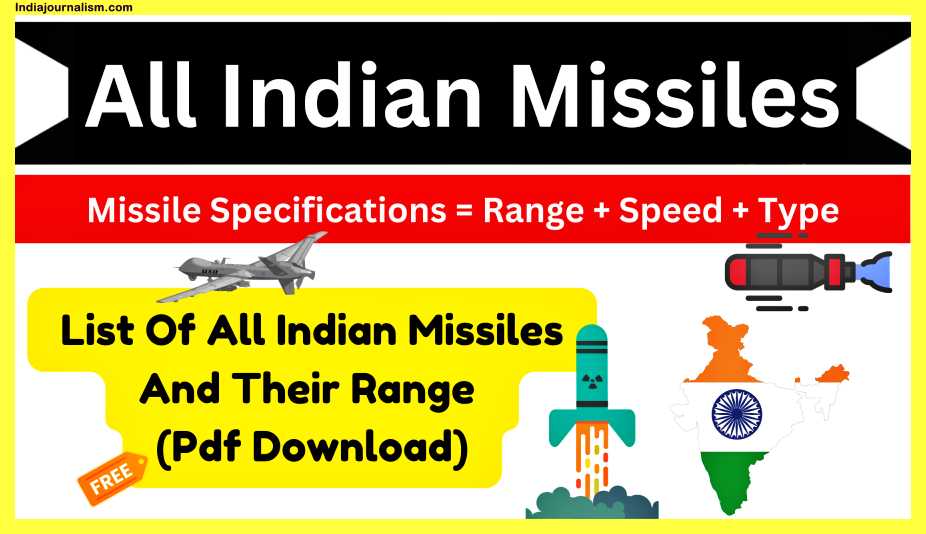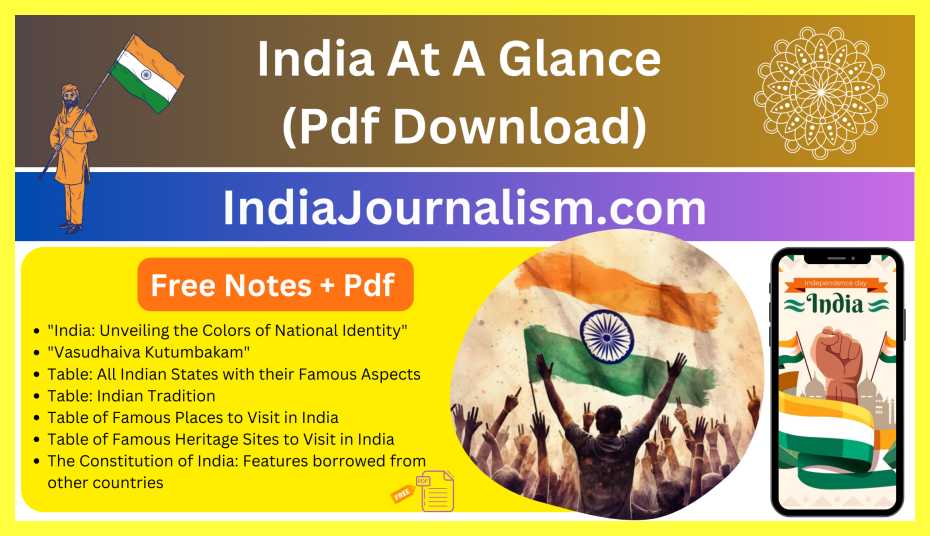List of all prime minister of India 1947 to 2024
Today we will give you the List of all prime minister of India 1947 to 2024 PDF Download, you can download this page as a pdf in All Languages (ICON: see on your right Top side) in 1 click, just go to the end of this page you will get a PDF Download Button and this PDF is very Important for your Upcoming Exams like UPSC, SSC, BANK, etc.
- India, the world’s largest democracy, has been led by a series of visionary leaders who have navigated the nation through triumphs and challenges alike. Since gaining independence in 1947, India has seen eighteen individuals serve as Prime Minister, each leaving an indelible mark on the country’s history and progress. This article takes a retrospective journey through the lives and legacies of these leaders, highlighting their significant contributions to the Indian story.
Table of all prime minister of India
Here’s a table with the Prime Ministers of India, along with the duration of their terms:
| No. | Prime Minister | Term Duration |
|---|---|---|
| 1 | Jawaharlal Nehru (15 August 1947 – 27 May 1964) | 16 years, 9 months |
| 2 | Gulzarilal Nanda (Acting) (27 May 1964 – 9 June 1964) | 13 days |
| 3 | Lal Bahadur Shastri (9 June 1964 – 11 January 1966) | 1 year, 7 months |
| 4 | Gulzarilal Nanda (Acting) (11 January 1966 – 24 January 1966) | 13 days |
| 5 | Indira Gandhi (24 January 1966 – 24 March 1977) | 11 years, 2 months |
| 6 | Morarji Desai (24 March 1977 – 28 July 1979) | 2 years, 4 months |
| 7 | Charan Singh (28 July 1979 – 14 January 1980) | 5 months, 17 days |
| 8 | Indira Gandhi (14 January 1980 – 31 October 1984) | 4 years, 9 months |
| 9 | Rajiv Gandhi (31 October 1984 – 2 December 1989) | 5 years, 1 month |
| 10 | Vishwanath Pratap Singh (2 December 1989 – 10 November 1990) | 11 months, 8 days |
| 11 | Chandra Shekhar (10 November 1990 – 21 June 1991) | 7 months, 11 days |
| 12 | P. V. Narasimha Rao (21 June 1991 – 16 May 1996) | 4 years, 10 months |
| 13 | Atal Bihari Vajpayee (16 May 1996 – 1 June 1996) | 16 days |
| 14 | H. D. Deve Gowda (1 June 1996 – 21 April 1997) | 10 months, 20 days |
| 15 | I. K. Gujral (21 April 1997 – 19 March 1998) | 10 months, 29 days |
| 16 | Atal Bihari Vajpayee (19 March 1998 – 22 May 2004) | 6 years, 2 months |
| 17 | Manmohan Singh (22 May 2004 – 26 May 2014) | 10 years, 4 days |
| 18 | Narendra Modi (26 May 2014 – present) | 10 Years+ Ongoing |
Also read: Complete UPSC FREE PPTs Series
Pioneers of the Indian Republic: A Comprehensive Exploration of India’s Prime Ministers
India, a diverse and culturally rich nation, has been shaped and guided by a succession of strong leaders who held the esteemed office of Prime Minister. From the moment of independence in 1947, these figures have tirelessly worked to carve the nation’s path in various fields, leaving an indelible mark on history. This article delves deep into the lives, achievements, and legacies of these Prime Ministers, tracing India’s political evolution over the years.
1. Jawaharlal Nehru (1947-1964)
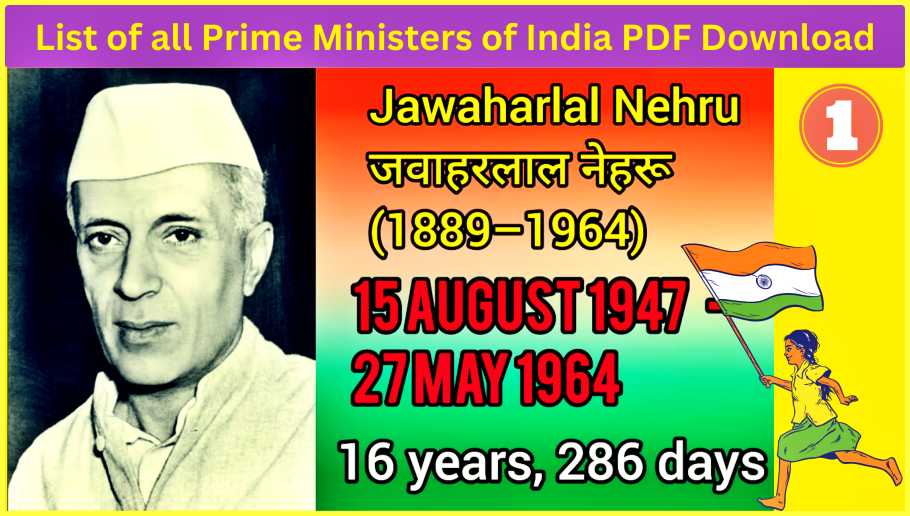
Jawaharlal Nehru, India’s first Prime Minister, Longest-serving Prime Minister of India (16 years and 286 days) was a visionary statesman and a key figure in the struggle for independence. His enduring leadership from 1947 until his death in 1964 helped India establish democratic institutions and set the stage for economic and social reforms. Fondly known as ‘Chacha Nehru,’ his policies emphasized education, industrialization, and social justice.
Here is a comprehensive biography table covering all important topics related to Jawaharlal Nehru:
| Full Name | Jawaharlal Nehru |
|---|---|
| Born | November 14, 1889 (Day Celebrated as Children’s Day) |
| Place of Birth | Allahabad, British India (now in Uttar Pradesh, India) |
| Parents | Motilal Nehru (Father), Swaruprani Thussu (Mother) |
| Education | Harrow School, England; Trinity College, Cambridge |
| Political Party | Indian National Congress |
| Spouse | Kamala Nehru (m. 1916, until her death in 1936) |
| Children | Indira Gandhi (only daughter, later became Prime Minister) |
| Occupation | Lawyer, Author, Politician |
| Role in Independence Movement | Active participant in the Indian freedom struggle, imprisoned multiple times by British authorities |
| Significant Dates | – Joined Indian National Congress in 1919 |
| – President of the Indian National Congress in 1929 | |
| – Became the Prime Minister of Interim Government of India in 1946 | |
| – First Prime Minister of India after independence in 1947 | |
| Key Accomplishments | – Architect of modern India, laid the foundation for industrialization, science, and technology |
| – Panchsheel Agreement: Promoted peaceful coexistence and non-interference in the internal affairs of nations | |
| – Advocated for secularism, democracy, and social justice | |
| Notable Works | – Author of “The Discovery of India,” a widely acclaimed book on India’s history, culture, and philosophy |
| International Relations | Played a significant role in the Non-Aligned Movement, promoting neutrality during the Cold War |
| Death | May 27, 1964, in New Delhi, India |
| Legacy | – Nehruvian socialism: His economic policies focused on a mixed economy, combining public and private sectors |
| – Institutionalized democracy in India, laying the foundation for a robust democratic system | |
| – Created strong educational and scientific infrastructure, including the establishment of IITs (Indian Institutes of Technology) | |
| – Nehru-Gandhi family, with his daughter Indira Gandhi and her descendants playing significant roles in Indian politics |
Jawaharlal Nehru’s legacy continues to shape modern India, and he is remembered as one of the key architects of the nation’s growth and development.
Table of All Famous Books Written by Jawaharlal Nehru
Here’s a table listing ten famous books written by Jawaharlal Nehru along with short descriptions:
| Book Title | Description |
|---|---|
| “The Discovery of India” | A comprehensive survey of Indian history, culture, and philosophy. It explores India’s past and its diversity, reflecting Nehru’s vision of India. |
| “Glimpses of World History” | A series of letters to his daughter Indira Gandhi, providing historical insights into world events and civilizations, making history accessible. |
| “An Autobiography” | Nehru’s autobiography detailing his childhood, political journey, and experiences in the Indian freedom struggle, offering a personal perspective. |
| “Letters from a Father to His Daughter” | A collection of letters written to his daughter Indira, introducing her to India’s history, culture, and traditions, making learning engaging and warm. |
| “The Unity of India” | Nehru discusses India’s diverse cultural and geographical aspects, emphasizing the unity amidst diversity and advocating for national integration. |
| “Toward Freedom: The Autobiography of Jawaharlal Nehru” | Nehru’s firsthand account of the Indian independence movement, chronicling his experiences, thoughts, and interactions during the struggle. |
| “Freedom at Midnight” | Co-authored with Dominique Lapierre, this book provides a detailed account of India’s independence and partition, capturing the events leading to 1947. |
| “Letters to Chief Ministers” | A collection of letters Nehru wrote to various Chief Ministers of Indian states, discussing governance, policy matters, and his vision for the country. |
| “The light that Failed: A Reckoning” | Nehru’s critical analysis of British imperialism and colonialism, examining the impact on India and other nations, reflecting his anti-imperialist stance. |
| “Independence and After: A Collection of Speeches 1946-1949” | This book compiles Nehru’s speeches during a crucial period of India’s history, reflecting his thoughts on the post-independence challenges and visions. |
These books showcase Nehru’s intellectual depth, his perspective on India’s past and future, and his role as a key figure in India’s history.
2. Gulzarilal Nanda (1964, 1966)
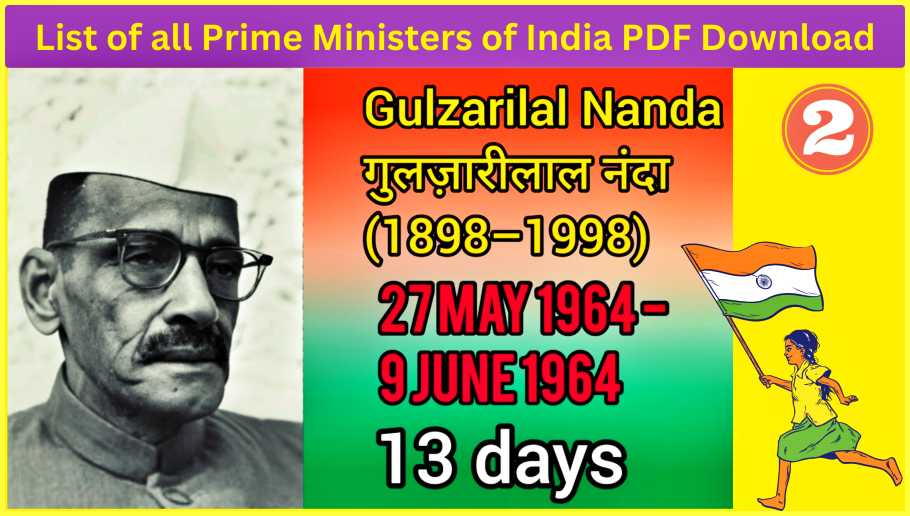
Gulzarilal Nanda served as the acting Prime Minister of India twice, first in 1964 after Nehru’s demise and later in 1966 following the passing of Lal Bahadur Shastri. India’s Second Prime Minister and Two times acting Prime Minister, Though his terms were brief, his contributions to the nation’s stability during transitional periods were significant.
Here is a comprehensive biography table covering all important topics related to Gulzarilal Nanda:
| Full Name | Gulzarilal Nanda |
|---|---|
| Born | July 4, 1898 |
| Place of Birth | Sialkot, British India (now in Pakistan) |
| Died | January 15, 1998 |
| Place of Death | Ahmedabad, Gujarat, India |
| Parents | Bhai Kishan Lal Nanda (Father), Daya Devi (Mother) |
| Education | Lahore University, University of Allahabad |
| Occupation | Economist, Politician, Prime Minister |
| Political Party | Indian National Congress |
| Spouse | Lakshmi Nanda (married in 1921, until her death in 1983) |
| Children | Two sons and one daughter |
| Key Roles | – Acting Prime Minister of India (1964, 1966) |
| – Deputy Chairman of the Planning Commission of India | |
| – Union Minister of Labour and Employment | |
| – Chief Minister of Bombay State | |
| – Interim Prime Minister of India after the death of Jawaharlal Nehru (1964) | |
| Contributions | – Played a crucial role during transitional periods in Indian politics |
| – Implemented several labor and employment reforms | |
| Notable Works | – Advocated for labor rights and social justice |
| – Worked towards economic and industrial development in India | |
| Legacy | Gulzarilal Nanda is remembered for his administrative acumen and dedication to social and labor reforms. His role as the interim Prime Minister of India twice was pivotal in maintaining stability during times of transition. His contributions to the labor sector and his commitment to social welfare continue to inspire generations in India. |
Gulzarilal Nanda’s legacy as a statesman and economist has left a lasting impact on Indian politics and governance.
3. Lal Bahadur Shastri (1964-1966)
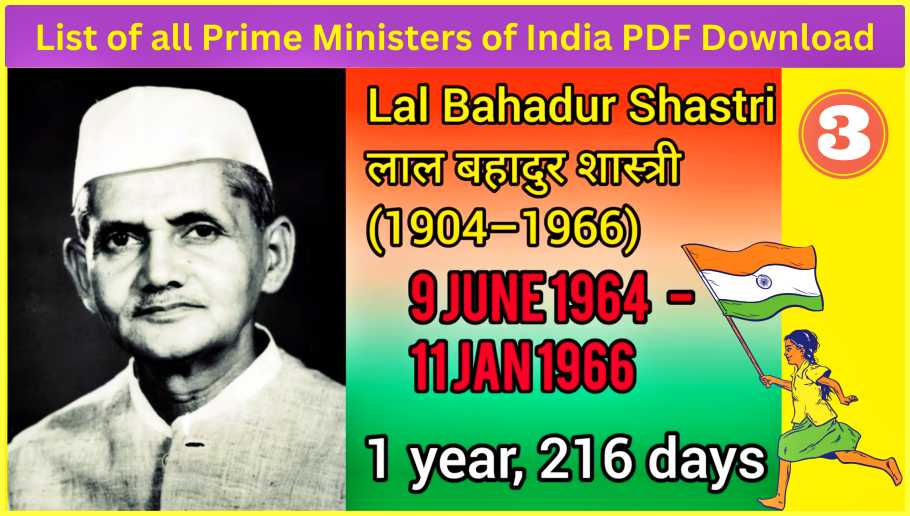
Lal Bahadur Shastri, the second Prime Minister, was a beacon of simplicity and integrity. His famous slogan ‘Jai Jawan Jai Kisan’ (“Hail the Soldier, Hail the Farmer”) captured the spirit of the nation during the 1965 Indo-Pak war. His untimely demise in 1966 was a great loss to the country.
Here is a comprehensive biography table covering all important topics related to Lal Bahadur Shastri:
| Full Name | Lal Bahadur Shastri |
|---|---|
| Born | October 2, 1904 |
| Place of Birth | Mughalsarai, United Provinces, British India (now in Uttar Pradesh, India) |
| Died | January 11, 1966 |
| Place of Death | Tashkent, Uzbek SSR, Soviet Union |
| Parents | Sharada Prasad Shrivastava (Father), Ramdulari Devi (Mother) |
| Education | Bachelor’s degree in Philosophy and Letters from Kashi Vidyapith |
| Spouse | Lalita Shastri (married in 1928) |
| Children | Six children, including sons Anil and Sunil, and daughters Kusum and Meera |
| Occupation | Freedom Fighter, Politician |
| Political Party | Indian National Congress |
| Key Roles | – Prime Minister of India (1964-1966) |
| – Minister of External Affairs (1964-1966) | |
| – Minister of Home Affairs (1961-1963) | |
| Notable Works | – Green Revolution: Initiated agricultural policies that led to significant increases in food production |
| – Post-Independence Wars: Led India during the 1965 Indo-Pakistani War | |
| Famous Slogan | “Jai Jawan Jai Kisan” (Hail the Soldier, Hail the Farmer) |
| Significant Events | – Instrumental in shaping India’s economic and agricultural policies during his tenure |
| – Signed the Tashkent Agreement with Ayub Khan, ending the 1965 Indo-Pakistani war | |
| Death | Passed away on January 11, 1966, under controversial circumstances in Tashkent, Uzbek SSR |
| Legacy | Lal Bahadur Shastri’s humility, integrity, and dedication to public service made him a beloved leader in India. His emphasis on self-reliance and agricultural growth significantly impacted India’s economy. His slogan “Jai Jawan Jai Kisan” (Hail the Soldier, Hail the Farmer) became a rallying cry for the nation. |
Lal Bahadur Shastri’s contributions to India’s growth, especially in the agricultural sector, and his leadership during times of war are remembered with great respect and admiration.
4. Gulzarilal Nanda (2 times) (11 January 1966 – 24 January 1966)
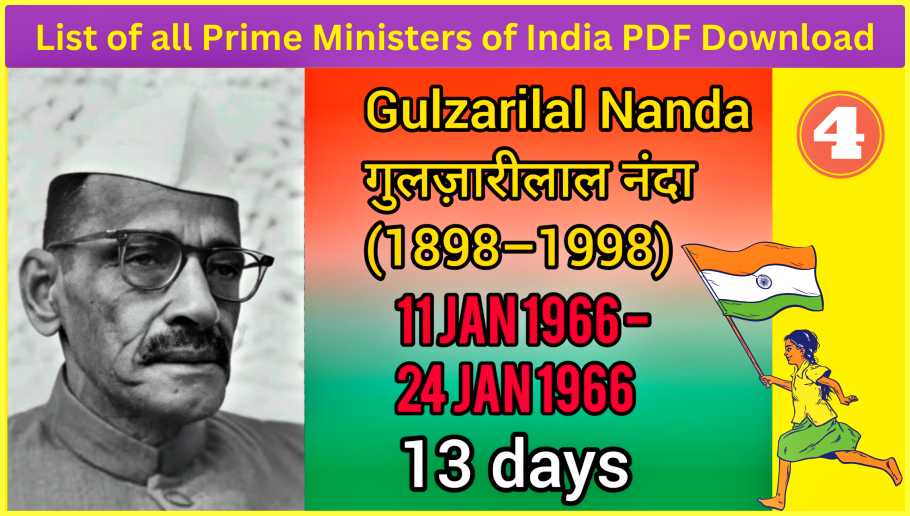
5. Indira Gandhi (1966-1977, 1980-1984) (2 times)

Indira Gandhi, the first woman Prime Minister, India’s second-longest-serving Prime Minister; India’s First Women Prime Minister; First Indian Prime Minister who received Bharat Ratna Award was a powerful and complex leader. She implemented economic and social reforms, led India to victory in the 1971 war, but also imposed a state of emergency in 1975, which remains a controversial period in Indian history. Her tragic assassination in 1984 marked a somber chapter.
Here is a comprehensive biography table covering all important topics related to Indira Gandhi:
| Full Name | Indira Priyadarshini Gandhi |
|---|---|
| Born | November 19, 1917 (Day Celebrated as Indira Gandhi Jayanti) |
| Place of Birth | Allahabad, United Provinces, British India (now in Uttar Pradesh, India) |
| Died | October 31, 1984 |
| Place of Death | New Delhi, India |
| Parents | Jawaharlal Nehru (Father), Kamala Nehru (Mother) |
| Education | Somerville College, University of Oxford, England |
| Spouse | Feroze Gandhi (married in 1942, until his death in 1960) |
| Children | Rajiv Gandhi (son), Sanjay Gandhi (son) |
| Occupation | Politician |
| Political Party | Indian National Congress |
| Key Roles | – Prime Minister of India (1966-1977, 1980-1984) |
| – President of the Indian National Congress | |
| Notable Achievements | – Implemented the Green Revolution, transforming India’s agricultural landscape |
| – Nationalized major banks and industries | |
| – Led India during the Bangladesh Liberation War in 1971, resulting in the creation of Bangladesh | |
| – Instituted the state of emergency from 1975 to 1977, known as the “Emergency Period” | |
| – Advocated for social and economic reforms, especially for the marginalized sections of society | |
| Key Policies | – Economic Policies: Implemented socialist economic policies, including nationalization of banks and industries |
| – Foreign Policy: Played a crucial role in the Non-Aligned Movement and India’s foreign relations | |
| – Social Reforms: Initiated policies aimed at poverty alleviation and social justice, including land reforms and rural development programs | |
| Assassination | Indira Gandhi was assassinated on October 31, 1984, by her bodyguards in retaliation for Operation Blue Star, a military action she ordered against Sikh separatists in the Golden Temple in Amritsar |
| Legacy | Indira Gandhi is remembered as one of India’s most powerful and influential leaders. Her tenure as Prime Minister saw both significant progress and controversial decisions. She is hailed for her contributions to India’s agricultural development, but her imposition of the Emergency and other authoritarian measures remain contentious topics in Indian political history. Despite this, her leadership played a crucial role in shaping modern India. |
Indira Gandhi’s legacy is complex, encompassing both her achievements in transforming India’s economy and her controversial decisions during her time in power. She remains a polarizing figure in Indian history.
Table of All Famous Books Written by Indira Gandhi
Indira Gandhi, the first female Prime Minister of India, was a prolific writer and authored several books. Here’s a table listing ten famous books written by her along with short descriptions:
| Book Title | Description |
|---|---|
| “My Truth” | Indira Gandhi’s autobiography, reflecting on her life, political career, and personal experiences, providing insights into her thoughts and decisions. |
| “India My Truth” | A personal account of her life, politics, and challenges faced during her time as the Prime Minister of India, offering a perspective on her leadership. |
| “Selected Speeches of Indira Gandhi” | A compilation of her notable speeches, showcasing her oratory skills, vision for India, and thoughts on various national and international issues. |
| “The Will to Live” | A collection of her speeches and writings, covering topics like democracy, peace, development, and her vision for India’s future, demonstrating her ideals. |
| “Indira Gandhi: Letters to Young People” | A compilation of letters she wrote to young people, sharing her views on life, politics, and society, encouraging the youth to actively engage in nation-building. |
| “In the Mirror of Memory” | A memoir exploring her childhood, political journey, and the complex relationship between power and personal life, offering a unique perspective on her life. |
| “India: Selected Speeches” | A collection of her speeches addressing diverse subjects, providing insights into her political ideology, policies, and vision for India’s progress and stability. |
| “Environmental Planning” | A scholarly work addressing environmental issues, emphasizing the importance of planning for sustainable development, reflecting her concerns for ecological matters. |
| “A Woman in Her Prime” | A reflection on her experiences as a woman in politics, discussing challenges faced, empowerment, and the evolving role of women in Indian society and politics. |
| “Rajiv Gandhi and Rama’s Kingdom” | A biography of her son, Rajiv Gandhi, delving into his life, achievements, and challenges, showcasing the journey of a leader who played a crucial role in India’s history. |
Please note that availability and titles of books might change over time. For the most current information, it’s best to refer to book retailers or official sources.
6. Morarji Desai (1977-1979)
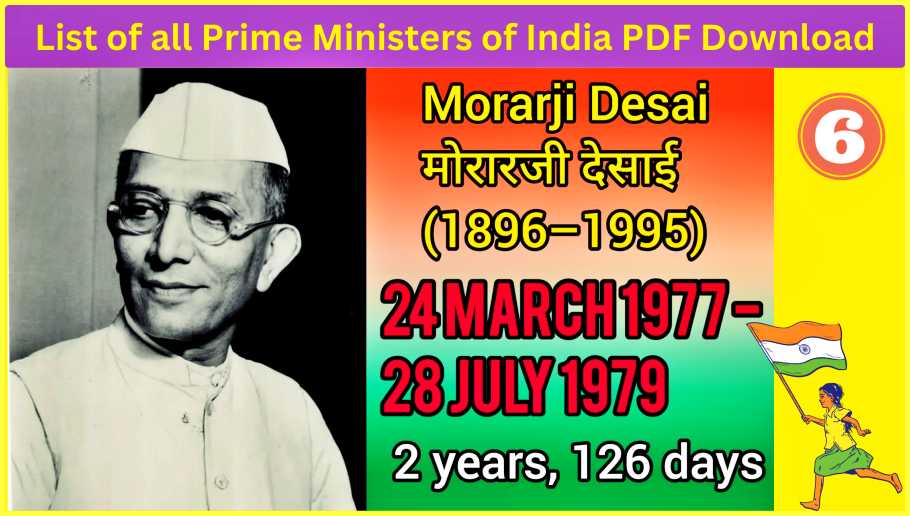
Morarji Desai, a staunch Gandhian and the first non-Congress Prime Minister, First Prime Minister of India who was not a member of the Congress; Received Pakistan’s highest civilian honour; The oldest person to become Prime Minister of India was instrumental in shaping India’s economic policies. His tenure was marked by his commitment to democracy and social justice. His leadership during the turbulent times of the late 1970s is remembered with respect.
Here is a comprehensive biography table covering all important topics related to Morarji Desai:
| Full Name | Morarji Ranchhodji Desai |
|---|---|
| Born | February 29, 1896 |
| Place of Birth | Bhadeli, Bombay Presidency, British India (now in Gujarat, India) |
| Died | April 10, 1995 |
| Place of Death | Mumbai, Maharashtra, India |
| Parents | Ranchhodji Desai (Father), Vajiaben (Mother) |
| Education | Bachelor’s degree in English and Law from Wilson College, Bombay |
| Spouse | Gujraben Desai (married in 1911) |
| Children | Two sons and one daughter |
| Occupation | Civil Servant, Freedom Fighter, Politician |
| Political Party | Indian National Congress, Janata Party |
| Key Roles | – Chief Minister of Bombay State (1952-1956) |
| – Finance Minister of India (1967-1969) | |
| – Deputy Prime Minister of India (1967-1969) | |
| – Prime Minister of India (1977-1979) | |
| Notable Achievements | – Implemented economic reforms, emphasizing austerity and fiscal discipline |
| – Promoted civil liberties and freedom of the press | |
| – Advocated for prohibition and promoted his teetotaler lifestyle | |
| International Relations | Advocated for non-alignment in foreign policy |
| Economic Policies | Focused on economic self-reliance and reduced dependence on foreign aid |
| Legacy | Morarji Desai is remembered for his austere lifestyle, dedication to social reforms, and significant role in Indian politics. He was the first Indian Prime Minister who was not a member of the Indian National Congress. Despite various challenges, his policies and commitment to integrity left a lasting impact on Indian governance. |
Morarji Desai’s legacy as a leader and his commitment to social reforms and economic self-reliance continue to inspire generations in India.
7. Charan Singh (1979-1980)
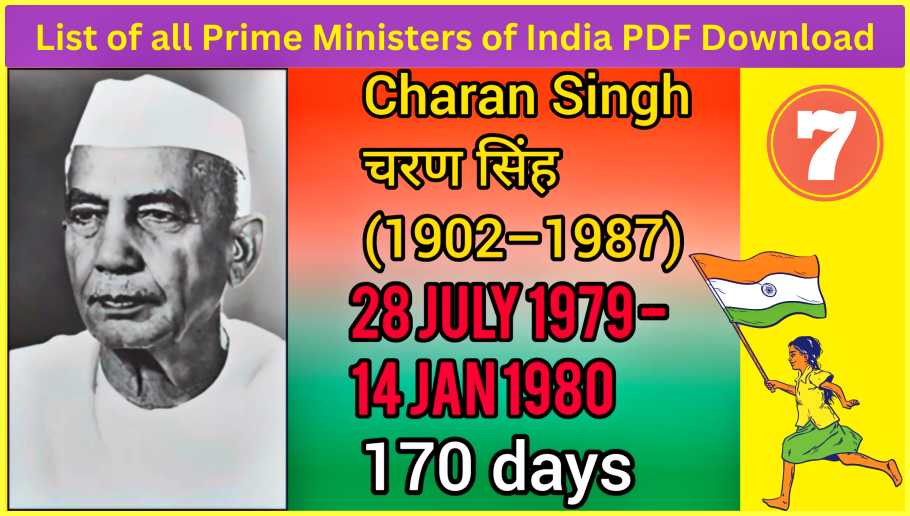
Championing the rights of farmers, The only Prime Minister who did not address the Parliament, Charan Singh’s brief term as Prime Minister highlighted his dedication to agrarian reforms. He emphasized the importance of empowering the agricultural sector, an issue that continues to be vital for India’s growth.
Here is a comprehensive biography table covering all important topics related to Charan Singh:
| Full Name | Charan Singh |
|---|---|
| Born | December 23, 1902 |
| Place of Birth | Noorpur, United Provinces, British India (now in Uttar Pradesh, India) |
| Died | May 29, 1987 |
| Place of Death | New Delhi, India |
| Parents | Sir Sobaran Singh (Father), Parbati (Mother) |
| Education | M.A. in Economics from Agra University, LL.B. from University of Lucknow |
| Spouse | Gayatri Devi (married in 1925) |
| Children | Five daughters and one son |
| Occupation | Farmer, Politician |
| Political Party | Bharatiya Lok Dal, Janata Party, Janata Dal, Lok Dal |
| Key Roles | – Chief Minister of Uttar Pradesh (1967-1968) |
| – Deputy Prime Minister of India (1977-1979) | |
| – Prime Minister of India (July 28, 1979 – January 14, 1980) | |
| Notable Achievements | – Implemented policies aimed at farmers’ welfare and rural development |
| – Advocated for social justice and land reforms | |
| – Initiated economic reforms and agricultural policies | |
| Legacy | Charan Singh is remembered as a champion of farmers’ rights and rural development. His advocacy for social and economic justice and his efforts to empower the agricultural community have left a significant impact on Indian politics and policies. |
Charan Singh’s contributions to Indian agriculture and rural development continue to be celebrated, and his legacy as a leader dedicated to the welfare of farmers and the rural population endures in the country’s collective memory.
8. Indira Gandhi (1966-1977, 1980-1984) (2 times)
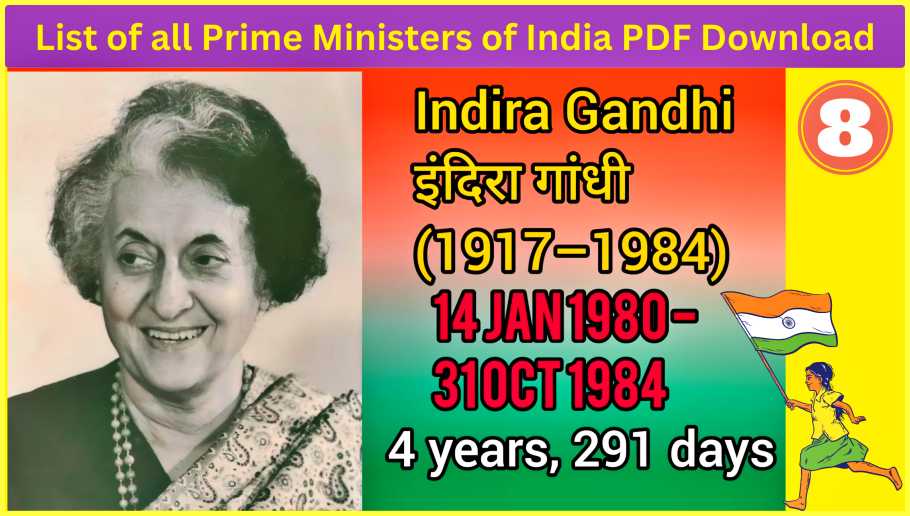
9. Rajiv Gandhi (1984-1989)
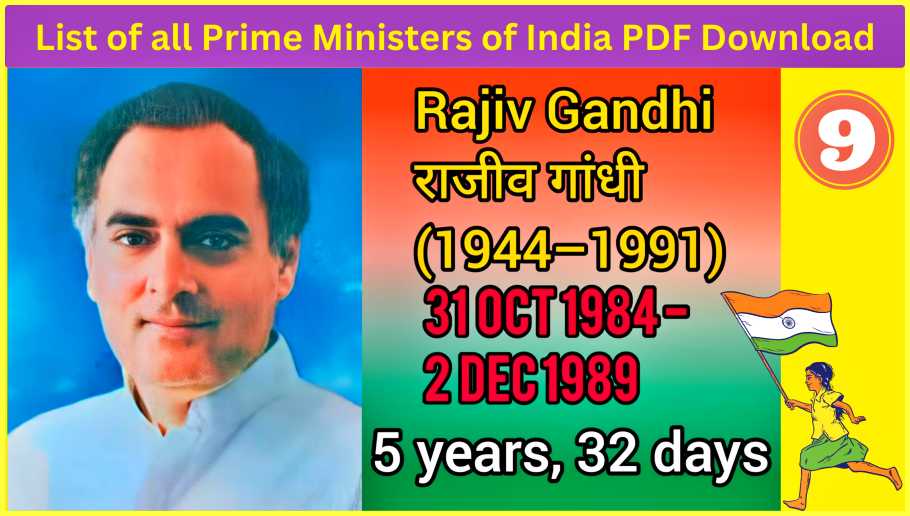
Rajiv Gandhi, the youngest Prime Minister of India, India’s youngest Prime Minister was a technocrat with a modern vision. His tenure witnessed technological advancements, though it was marred by the Bofors scandal. His tragic assassination in 1991 shocked the nation and marked the end of a significant political era.
Here is a comprehensive biography table covering all important topics related to Rajiv Gandhi:
| Full Name | Rajiv Ratna Gandhi |
|---|---|
| Born | August 20, 1944 (Day Celebrated as Rajiv Gandhi Sadbhavana Diwas) |
| Place of Birth | Bombay, British India (now Mumbai, Maharashtra, India) |
| Died | May 21, 1991 |
| Place of Death | Sriperumbudur, Tamil Nadu, India |
| Parents | Indira Gandhi (Mother), Feroze Gandhi (Father) |
| Education | Trinity College, Cambridge (1962-1965) |
| Spouse | Sonia Gandhi (m. 1968) |
| Children | Rahul Gandhi (son), Priyanka Gandhi Vadra (daughter) |
| Occupation | Pilot, Politician |
| Political Party | Indian National Congress |
| Key Roles | – Prime Minister of India (December 31, 1984 – December 2, 1989) |
| – General Secretary of the Indian National Congress | |
| – Member of Parliament | |
| Notable Achievements | – Launched economic and technological reforms with initiatives like the introduction of computers in India |
| – Contributed to the improvement of India’s IT and telecom sectors | |
| – Panchayati Raj system: Devolved power to local governments | |
| – Focused on education and literacy campaigns | |
| – Played a significant role in the 1987 Sri Lanka Peace Accord | |
| Legacy | Rajiv Gandhi is remembered for his efforts to modernize India’s economy and infrastructure. He encouraged advancements in technology and telecommunications, laying the foundation for the country’s IT industry. Despite his assassination in 1991, his vision for a technologically advanced and progressive India continues to influence the nation’s development. |
Rajiv Gandhi’s legacy as a reformist leader, particularly in the fields of technology and education, remains a pivotal chapter in India’s history. His contributions to the country’s modernization are widely acknowledged.
Table of All Famous Books Written by Rajiv Gandhi
Rajiv Gandhi, the sixth Prime Minister of India, was primarily involved in politics and didn’t have an extensive career as an author. However, he did contribute forewords and introductions to several books. Here are some of his notable works:
| Book Title | Description |
|---|---|
| “Rajiv” by Inder Malhotra | A biography of Rajiv Gandhi, offering insights into his life, political career, and contributions to Indian politics. |
| “Rajiv Gandhi: Visionary of Modern India” by Mohan Delkar | This book explores Rajiv Gandhi’s vision for a modern and technologically advanced India, focusing on his policies and initiatives. |
| “Rajiv Gandhi: The Man Who Modernized India” by Gaurav Sharma | A detailed account of Rajiv Gandhi’s life, highlighting his efforts in modernizing India through technology, education, and social reforms. |
| “Rajiv: A Life” by Krishna Pradhan | A biography that delves into Rajiv Gandhi’s personal and political life, discussing his family, early years, and leadership as Prime Minister. |
| “Rajiv Gandhi: The Last Prime Minister of the Twentieth Century” by Rupa Chaterjee | This book examines Rajiv Gandhi’s tenure as Prime Minister, focusing on his achievements, challenges, and the political landscape of the time. |
| “To Be or Not to Be” by Rajiv Gandhi | A collection of Rajiv Gandhi’s speeches, reflections, and thoughts on various topics, offering insights into his vision and ideas for India’s future. |
| “New Leadership” by Rajiv Gandhi | A collection of speeches and articles by Rajiv Gandhi, outlining his vision for India and his ideas on governance, technology, and socio-economic progress. |
| “Indian Way: How India’s Democracy Works” by Rajiv Gandhi | A book discussing the functioning of Indian democracy, emphasizing the values of diversity, tolerance, and secularism, penned by Rajiv Gandhi. |
| “India’s Youth: An Appraisal of Problems and Prospects” by Rajiv Gandhi | Rajiv Gandhi’s thoughts on India’s youth population, their challenges, and the potential they hold for the nation’s progress, offering policy suggestions. |
| “Rajiv Gandhi: A Profile in Courage” by Pupul Jayakar | A biography that portrays Rajiv Gandhi’s leadership during crucial moments in Indian history, showcasing his courage and determination in the face of challenges. |
Please note that while these books contain content related to Rajiv Gandhi, they are not necessarily authored by him but instead focus on his life, vision, and contributions to India.
10. Vishwanath Pratap Singh (1989-1990)
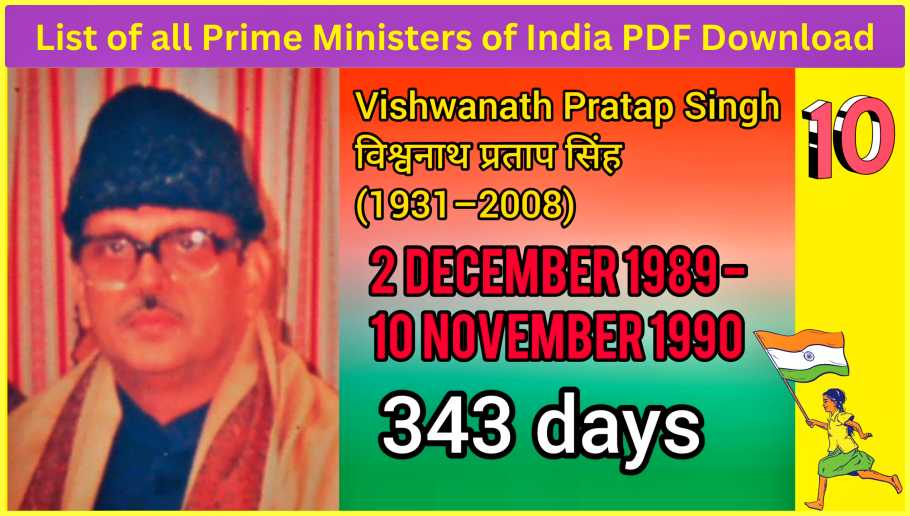
V.P. Singh, a champion of social justice, implemented the Mandal Commission recommendations, providing reservations in government jobs and educational institutions. His tenure was marked by a focus on inclusive growth, addressing historical inequalities.
Here is a comprehensive biography table covering all important topics related to Vishwanath Pratap Singh:
| Full Name | Vishwanath Pratap Singh |
|---|---|
| Born | June 25, 1930 |
| Place of Birth | Fatehpur, United Provinces, British India (now in Uttar Pradesh, India) |
| Died | November 27, 2008 |
| Place of Death | New Delhi, India |
| Parents | Raja Bahadur Ram Gopal Singh (Father), Mahadevi Singh (Mother) |
| Education | Bachelor’s degree from Pune University, LL.B. from Lucknow University |
| Spouse | Sita Kumari (married in 1955) |
| Children | Ajeya Singh (son) |
| Occupation | Civil Servant, Politician |
| Political Party | Indian National Congress (Before 1987), Janata Dal (1987-1988), Janata Dal (Socialist) (1988-1989) |
| Key Roles | – Chief Minister of Uttar Pradesh (1980-1982) |
| – Minister of Finance (1984-1987) | |
| – Eighth Prime Minister of India (December 2, 1989 – November 10, 1990) | |
| Notable Achievements | – Economic Reforms: Initiated economic liberalization measures and reduced government regulations |
| – Mandal Commission Implementation: Implemented the Mandal Commission recommendations for reservations in government jobs | |
| – Anti-Corruption Campaign: Launched campaigns against corruption in the government | |
| Key Policies | – Implemented the Mandal Commission report, which aimed to provide social and economic justice to backward classes |
| – Initiated economic reforms, liberalizing the economy and reducing license raj | |
| Legacy | Vishwanath Pratap Singh is remembered for his efforts to address social and economic inequality through policies like affirmative action in government jobs. His government’s economic reforms laid the groundwork for later liberalization efforts in India. Despite his short tenure as Prime Minister, his impact on Indian politics and social policies is significant. |
Vishwanath Pratap Singh’s contributions to social justice and economic reform, particularly through the implementation of the Mandal Commission recommendations, have left a lasting impact on Indian politics and policies.
11. Chandra Shekhar (1990-1991)
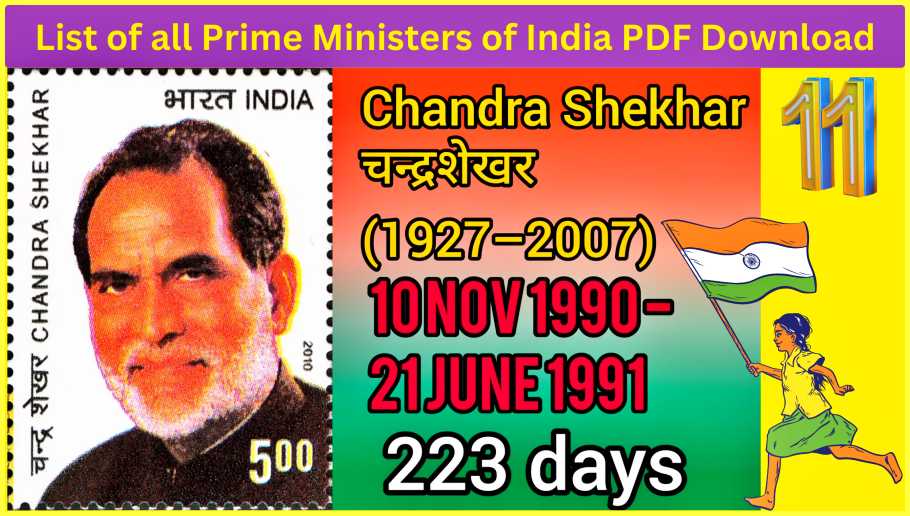
Chandra Shekhar led a minority government amidst challenging circumstances. His term saw economic crises and political uncertainties. Despite the difficulties, he contributed to the political discourse of the nation.
Here is a comprehensive biography table covering all important topics related to Chandra Shekhar:
| Full Name | Chandra Shekhar Singh |
|---|---|
| Born | July 1, 1927 |
| Place of Birth | Ibrahimpatti, United Provinces, British India (now in Uttar Pradesh, India) |
| Died | July 8, 2007 |
| Place of Death | New Delhi, India |
| Parents | Janaki Devi (Mother) |
| Education | Bachelor’s degree in Science from Allahabad University |
| Spouse | Duja Devi (married in 1954) |
| Children | Son: Pankaj Shekhar, Daughter: Renu Shekhar |
| Occupation | Politician, Prime Minister of India |
| Political Party | Indian National Congress (Until 1977), Janata Party (1977-1988), Janata Dal (1988-1999), Samajwadi Janata Party (1999-2008) |
| Key Roles | – Chief Minister of Uttar Pradesh (1967-1968) |
| – Eighth Prime Minister of India (November 10, 1990 – June 21, 1991) | |
| Notable Achievements | – Initiated economic liberalization measures |
| – Advocated for social justice and empowerment of marginalized communities | |
| Key Policies | – Economic Reforms: Promoted economic liberalization policies and reduced government regulations |
| – Social Justice: Advocated for policies to uplift backward classes and empower women | |
| Legacy | Chandra Shekhar is remembered as a leader who advocated for social justice, economic reforms, and political integrity. His tenure as Prime Minister, although short-lived, saw efforts towards economic liberalization and social empowerment. His commitment to democratic values and social equality left a lasting impact on Indian politics. |
Chandra Shekhar’s contributions to economic reforms and social justice, as well as his dedication to democratic principles, continue to influence the political landscape in India.
12. P.V. Narasimha Rao (1991-1996)
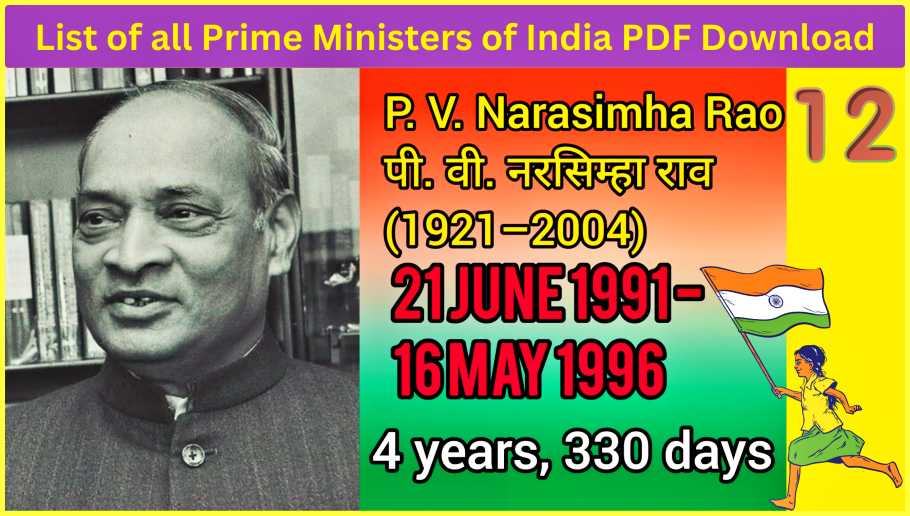
P.V. Narasimha Rao, First South Indian Prime Minister, a reformer at heart, initiated economic liberalization, transforming India’s economy. His leadership during the 1991 economic reforms laid the foundation for India’s global economic integration, earning him praise for his foresight.
Here is a comprehensive biography table covering all important topics related to P.V. Narasimha Rao:
| Full Name | Pamulaparti Venkata Narasimha Rao |
|---|---|
| Born | June 28, 1921 |
| Place of Birth | Laknepalli, Warangal District, Hyderabad State, British India (now in Telangana, India) |
| Died | December 23, 2004 |
| Place of Death | New Delhi, India |
| Parents | Ranga Rao (Father), Rukminiamma (Mother) |
| Education | Master’s degree in Law from Osmania University |
| Spouse | Satyamma (married in 1943) |
| Children | Three Sons: P.V. Rangarao, P.V. Rajeshwar Rao, P.V. Prabhakara Rao |
| Occupation | Lawyer, Politician, Writer |
| Political Party | Indian National Congress |
| Key Roles | – Ninth Prime Minister of India (June 21, 1991 – May 16, 1996) |
| – Chief Minister of Andhra Pradesh (1971–1973) | |
| – Minister of External Affairs (1980–1984) | |
| Notable Achievements | – Economic Reforms: Initiated economic liberalization, dismantling the License Raj, and promoting globalization |
| – Foreign Policy: Improved relations with neighboring countries, including China and the United States | |
| – Education Reforms: Advocated for education reforms and promoted information technology | |
| Key Policies | – Economic Liberalization: Introduced economic reforms, leading to significant growth in the Indian economy |
| – Foreign Policy: Focused on strengthening India’s global presence and fostering international relations | |
| Legacy | P.V. Narasimha Rao is remembered as the architect of economic reforms in India. His policies liberalized the economy and paved the way for India’s rapid economic growth in the 1990s. He is also credited with modernizing India’s foreign policy and strengthening its international ties. Rao’s leadership during a period of economic crisis and his contributions to shaping modern India continue to be widely acknowledged. |
P.V. Narasimha Rao’s legacy as a visionary leader, especially in economic and foreign policy matters, has left an indelible mark on India’s development trajectory.
Table of All Famous Books Written by P.V. Narasimha Rao
P.V. Narasimha Rao, the ninth Prime Minister of India, was a prolific writer and scholar. Here’s a table listing ten famous books written by him along with short descriptions:
| Book Title | Description |
|---|---|
| “The Insider” | An autobiography providing insights into Rao’s political career, his role in shaping India’s economic policies, and his perspective on key events. |
| “Ayodhya 6 December 1992” | A detailed account of the Babri Masjid demolition incident in Ayodhya, analyzing the political and social dynamics surrounding the event. |
| “The Great Indian Experience” | A collection of essays covering a wide range of topics, including economics, politics, and culture, reflecting Rao’s depth of knowledge and analysis. |
| “The Indian Challenge” | A book exploring the challenges faced by India in the global context, focusing on economic reforms, globalization, and the country’s evolving role. |
| “Conflict and Diplomacy” | A study of international relations and diplomacy, examining various global conflicts and diplomatic strategies, providing insights into global politics. |
| “The Upside-Down Pyramid: Making Subsidies Work” | Rao discusses the subsidy system in India, proposing reforms and solutions to make subsidies more effective and beneficial for the intended recipients. |
| “The Finished Man” | A novel set in the backdrop of Indian politics, delving into the complexities of power, relationships, and morality, showcasing Rao’s storytelling skills. |
| “The Luminous Sparks” | A collection of philosophical and introspective essays exploring topics like spirituality, self-awareness, and human consciousness, reflecting Rao’s depth of thought. |
| “The Ayodhya Causus” | A historical analysis of the Ayodhya dispute, tracing its origins, legal battles, and political implications, providing a comprehensive overview of the issue. |
| “The Crisis Within: On Knowledge and Education in India” | Rao reflects on the challenges faced by India’s education system, offering insights into the need for reforms and improvements in the country’s educational sector. |
Please note that availability and titles of books might change over time. For the most current information, it’s best to refer to book retailers or official sources.
13. (16 May 1996 – 1 June 1996) (2 Times)
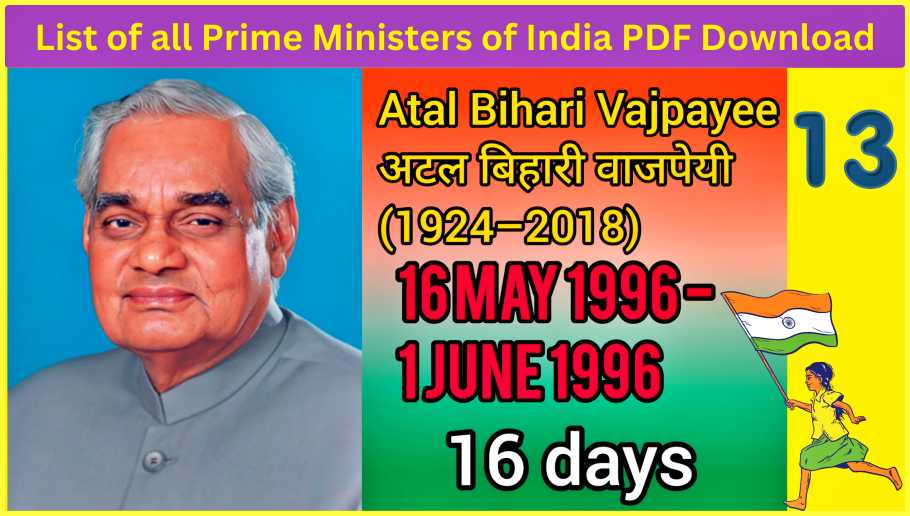
14. H.D. Deve Gowda (1996-1997)
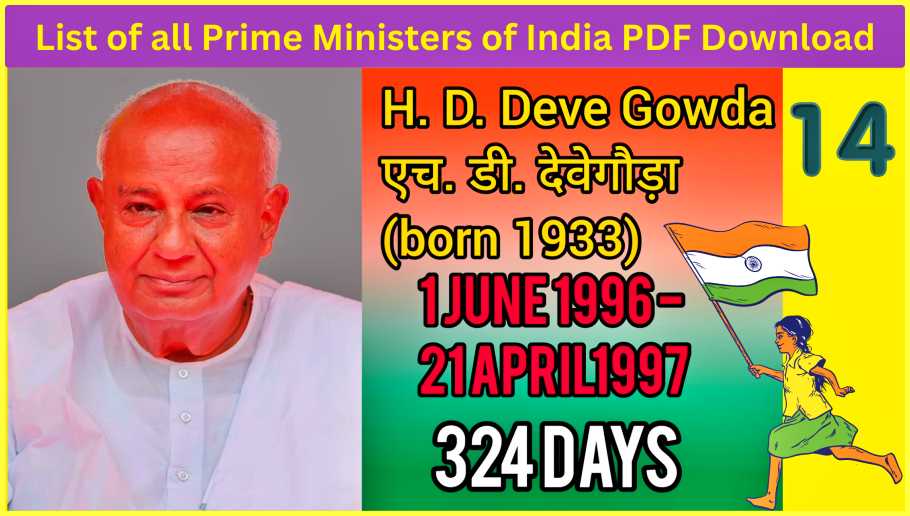
H.D. Deve Gowda, a respected regional leader, held the office amidst political complexities. His emphasis on regional development and federal cooperation marked his tenure.
Here is a comprehensive biography table covering all important topics related to H.D. Deve Gowda:
| Full Name | Haradanahalli Doddegowda Deve Gowda |
|---|---|
| Born | May 18, 1933 |
| Place of Birth | Haradanahalli, Holenarasipura, Kingdom of Mysore, British India (now in Karnataka, India) |
| Parents | Dodde Gowda (Father), Devamma (Mother) |
| Spouse | Chennamma Deve Gowda (married in 1954) |
| Children | H.D. Revanna (son), H.D. Kumaraswamy (son) |
| Occupation | Politician |
| Political Party | Janata Dal (Secular) |
| Key Roles | – Chief Minister of Karnataka (1994-1996) |
| – Eleventh Prime Minister of India (June 1, 1996 – April 21, 1997) | |
| – Member of Parliament | |
| Notable Achievements | – As Prime Minister, he focused on economic reforms, rural development, and social welfare |
| – Worked towards agricultural reforms and rural development in Karnataka | |
| Key Policies | – Economic Reforms: During his tenure as Prime Minister, he aimed at economic liberalization and privatization |
| – Rural Development: Advocated for rural development projects and initiatives to improve the lives of farmers and rural communities | |
| Legacy | H.D. Deve Gowda is known for his contributions to Karnataka’s rural development and his term as the Prime Minister during a period of political coalition. His focus on economic reforms and social welfare initiatives, especially in rural areas, continues to be recognized in Indian politics. As a prominent leader from Karnataka, his political influence remains significant in the region. |
H.D. Deve Gowda’s legacy as a leader who focused on rural development and economic reforms, as well as his term as the Prime Minister of India, continues to shape the political landscape in Karnataka and at the national level.
15. I.K. Gujral (1997-1998)
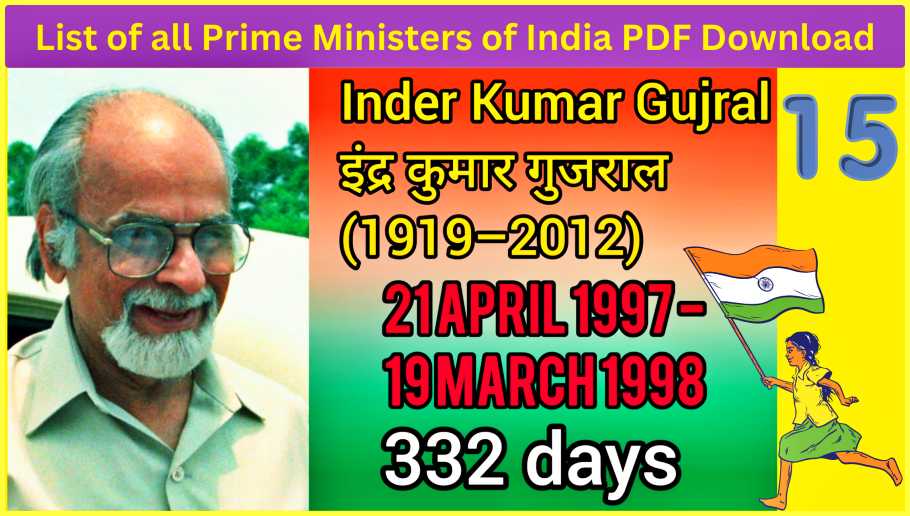
I.K. Gujral, known for the Gujral Doctrine, aimed at fostering peaceful relations with neighboring countries. His focus on diplomatic initiatives left an impact on India’s foreign policy.
Here is a comprehensive biography table covering all important topics related to I.K. Gujral:
| Full Name | Inder Kumar Gujral |
|---|---|
| Born | December 4, 1919 |
| Place of Birth | Jhelum, British India (now in Punjab, Pakistan) |
| Died | November 30, 2012 |
| Place of Death | Gurgaon, Haryana, India |
| Parents | Avtar Narain Gujral (Father) |
| Spouse | Shiela Gujral (married in 1945) |
| Children | Naresh Gujral (son), Vishal Gujral (son) |
| Occupation | Diplomat, Politician |
| Political Party | Indian National Congress (Before 1988), Janata Dal (1988-2008), Janata Dal (Secular) (2008-2012) |
| Key Roles | – Eighth Prime Minister of India (April 21, 1997 – March 19, 1998) |
| – Minister of External Affairs (1989-1990) | |
| – Minister of Finance (1997) | |
| – Ambassador to the Soviet Union, Nepal, and Belgium | |
| Notable Achievements | – Advocated for foreign policy of peace and friendship with neighboring countries |
| – Implemented economic reforms and initiated the Gujral Doctrine in foreign relations | |
| – Contributed to improving India’s relations with its neighbors, especially Pakistan | |
| Key Policies | – Gujral Doctrine: Advocated for friendly relations with neighboring countries without expecting reciprocity |
| – Economic Reforms: Supported economic liberalization and reforms to boost the Indian economy | |
| Legacy | I.K. Gujral is remembered for his significant contributions to Indian foreign policy and his role in improving relations with neighboring countries. His approach of peaceful coexistence, known as the Gujral Doctrine, continues to shape India’s foreign relations strategy. He is also recognized for his diplomatic skills and commitment to regional peace and stability. |
I.K. Gujral’s legacy as a statesman and his contributions to India’s foreign policy, especially in promoting peace and friendship with neighboring nations, continue to be widely respected in Indian politics.
16. Atal Bihari Vajpayee (1996, 1998-2004) (2 times)
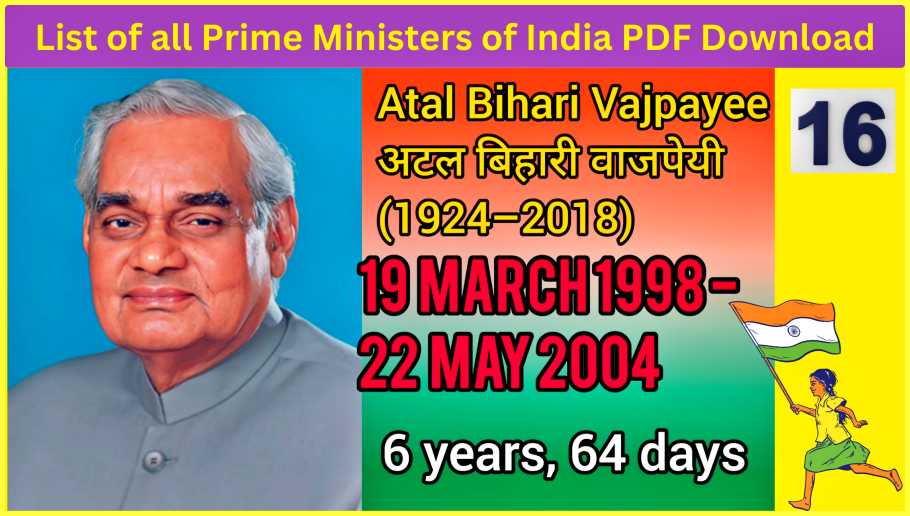
Atal Bihari Vajpayee, a statesman and orator, served three non-consecutive terms as Prime Minister. His tenure witnessed the Pokhran II nuclear tests and a renewed focus on infrastructure development. His contributions to Indian foreign policy and his efforts for peace with Pakistan are noteworthy.
Here is a comprehensive biography table covering all important topics related to Atal Bihari Vajpayee:
| Full Name | Atal Bihari Vajpayee |
|---|---|
| Born | December 25, 1924 (Day Celebrated as Good Governance Day) |
| Place of Birth | Gwalior State, British India (now in Madhya Pradesh, India) |
| Died | August 16, 2018 |
| Place of Death | New Delhi, India |
| Parents | Krishna Bihari Vajpayee (Father), Krishna Devi (Mother) |
| Education | M.A. in Political Science from DAV College, Kanpur |
| Spouse | None (unmarried) |
| Occupation | Politician, Poet |
| Political Party | Bharatiya Jana Sangh, Bharatiya Janata Party |
| Key Roles | – Eleventh Prime Minister of India (May 19, 1996 – June 1, 1996; March 19, 1998 – May 22, 2004) |
| – Minister of External Affairs (1977-1979) | |
| – Minister of External Affairs (1980-1984) | |
| Notable Achievements | – Led India during the Kargil War in 1999 |
| – Conducted successful nuclear tests in Pokhran in 1998 | |
| – Advocated for economic reforms and infrastructure development | |
| Key Policies | – Economic Reforms: Initiated economic liberalization, privatization, and globalization policies |
| – Foreign Policy: Improved relations with the United States and neighboring countries | |
| – Nuclear Policy: Asserted India’s nuclear capability and conducted nuclear tests in 1998 | |
| – Infrastructure Development: Focused on roads, telecom, and power sectors | |
| Legacy | Atal Bihari Vajpayee is remembered as a charismatic statesman, an eloquent speaker, and a poet. He played a significant role in shaping India’s economic policies and foreign relations. His tenure saw crucial reforms, and he remains a respected figure in Indian politics. His contributions to the nation, especially during challenging times, continue to inspire future generations. |
Atal Bihari Vajpayee’s legacy as a visionary leader, eloquent orator, and staunch advocate of economic and infrastructural development endures in the hearts of the Indian people.
Table of All Famous Books Written by Atal Bihari Vajpayee
Atal Bihari Vajpayee, the 10th Prime Minister of India, was a renowned poet and statesman. Here’s a list of ten famous books written by him, primarily collections of his poetry, along with short descriptions:
| Book Title | Description |
|---|---|
| “Meri Sansadiya Yatra” | An autobiography covering Vajpayee’s political journey, experiences in Parliament, and his perspectives on Indian politics and governance. |
| “Nayi Disha” | A collection of speeches and writings reflecting Vajpayee’s vision for India, outlining his ideas on governance, economy, and social development. |
| “Amar Balidan” | A compilation of biographical sketches of political leaders who sacrificed their lives for India, showcasing their contributions to the nation. |
| “Kaidi Kaviraj Ki Kundalian” | A collection of poems that reflect Vajpayee’s poetic talent, covering themes like love, patriotism, and social issues, showcasing his literary prowess. |
| “Sankalp Kaal” | A collection of poems expressing Vajpayee’s thoughts on life, politics, and society, reflecting his deep contemplation and insights into human nature. |
| “Agni-Pankh” | A compilation of Vajpayee’s speeches and writings, addressing diverse subjects, including national security, foreign policy, and economic development. |
| “Naye Chuninda Prasang” | A collection of select speeches by Vajpayee, highlighting significant moments in his political career and his views on key issues facing the nation. |
| “Kuchh Lekh, Kuchh Bhashan” | A book containing a selection of Vajpayee’s writings and speeches, offering readers a glimpse into his perspectives on various political and social issues. |
| “Mere Sangharshmai Jeevan Evam Dhyey” | An autobiographical account of Vajpayee’s life, struggles, and goals, portraying his journey from a young activist to a prominent political leader. |
| “Aao Phir Se Diya Jalayen” | A collection of poems emphasizing the importance of hope, courage, and collective effort in the face of challenges, showcasing Vajpayee’s optimism. |
Please note that these titles are in Hindi, reflecting the original language of Vajpayee’s works. Translations of some of his poetry and speeches are available in English as well.
17. Manmohan Singh (2004-2014)

Manmohan Singh, First Sikh Prime Minister of India, an eminent economist, championed economic reforms and globalization. Under his leadership, India experienced rapid economic growth and modernization. His tenure emphasized inclusive development and social welfare programs.
Here is a comprehensive biography table covering all important topics related to Manmohan Singh:
| Full Name | Manmohan Singh |
|---|---|
| Born | September 26, 1932 |
| Place of Birth | Gah, British India (now in Punjab, Pakistan) |
| Education | DPhil in Economics from University of Oxford, England |
| Spouse | Gursharan Kaur (married in 1958) |
| Children | Three daughters: Upinder Singh, Daman Singh, Amrit Singh |
| Occupation | Economist, Politician |
| Political Party | Indian National Congress |
| Key Roles | – Thirteenth Prime Minister of India (May 22, 2004 – May 26, 2014) |
| – Minister of Finance (1991-1996) | |
| – Governor of Reserve Bank of India (1982-1985) | |
| Notable Achievements | – Led India during a period of economic reform and liberalization, commonly known as the “Manmohan Singh reforms” |
| – Initiated economic policies to boost India’s growth, including the dismantling of the License Raj | |
| – Championed pro-liberalization and globalization stances | |
| – Signed the historic Indo-U.S. Civil Nuclear Agreement in 2005 | |
| Key Policies | – Economic Reforms: Implemented policies to open up the Indian economy, promote foreign investment, and spur economic growth |
| – Foreign Policy: Focused on strengthening India’s global ties, including improving relations with the United States and neighboring countries | |
| – Social Policies: Launched several social welfare programs, including the National Rural Employment Guarantee Scheme (NREGA) | |
| Legacy | Manmohan Singh is remembered as the architect of India’s economic reforms in the 1990s and for his contributions to India’s economic growth and global standing. His tenure as Prime Minister oversaw significant economic liberalization and social welfare initiatives. |
Manmohan Singh’s legacy as a reformer, economist, and statesman is marked by his role in shaping India’s economic policies and global relations. He continues to be respected for his pivotal role in India’s economic transformation.
Table of All Famous Books Written by Dr. Manmohan Singh
As of my knowledge cutoff in September 2021, Dr. Manmohan Singh, the 13th Prime Minister of India, has not authored many books. However, he has contributed to numerous research papers and publications in the field of economics. While there might be more recent publications post-2021, here are a few books and writings associated with him:
| Book Title | Description |
|---|---|
| “India’s Export Trends and Prospects for Self-Sustained Growth” | A scholarly work published in 1964, which remains influential in the field of economics, analyzing India’s export trends and future growth prospects. |
| “Monetary Policy and Fiscal Policy” | A detailed analysis of monetary and fiscal policies, exploring their interlinkages and their roles in economic stability and growth. |
| “Economic History of Punjab: 1901-1947” | A historical study examining the economic development and changes in Punjab during the first half of the 20th century. |
| “Fiscal Federalism in India” | A comprehensive analysis of fiscal federalism in India, exploring the division of fiscal powers and responsibilities between central and state governments. |
| “Globalization and Its Impact on Indian Economy” | A research paper that delves into the effects of globalization on India’s economy, discussing both the positive aspects and the challenges it brings. |
| “India’s Economy: Performance and Challenges” | A compilation of articles and essays written by Dr. Manmohan Singh, addressing various economic issues facing India, including growth, reforms, and challenges. |
| “Reforming the International Monetary and Financial System” | An academic paper discussing reforms needed in the international monetary and financial system, co-authored by Dr. Singh and other economists. |
| “Beyond the Crisis: Challenges and Opportunities” | A collection of essays discussing the global financial crisis of 2008 and its implications, exploring the challenges and opportunities for the world economy. |
| “The Economy of India” | A comprehensive book that provides an overview of India’s economy, covering various aspects of economic development, policies, and challenges. |
| “India’s Pathway through Financial Crisis” | An analysis of India’s economic response to the global financial crisis of 2008, discussing the measures taken and the lessons learned from the crisis. |
| “Selected Works of Manmohan Singh: Volume 1-4” | A compilation of speeches, articles, and interviews by Dr. Manmohan Singh during his tenure as Prime Minister, providing insights into his economic and policy views. |
Please note that these are primarily academic and research works, reflecting Dr. Singh’s expertise in economics and policy analysis. For more recent publications or specific details, I recommend checking academic databases and official sources.
18. Narendra Modi (2014-Incumbent)
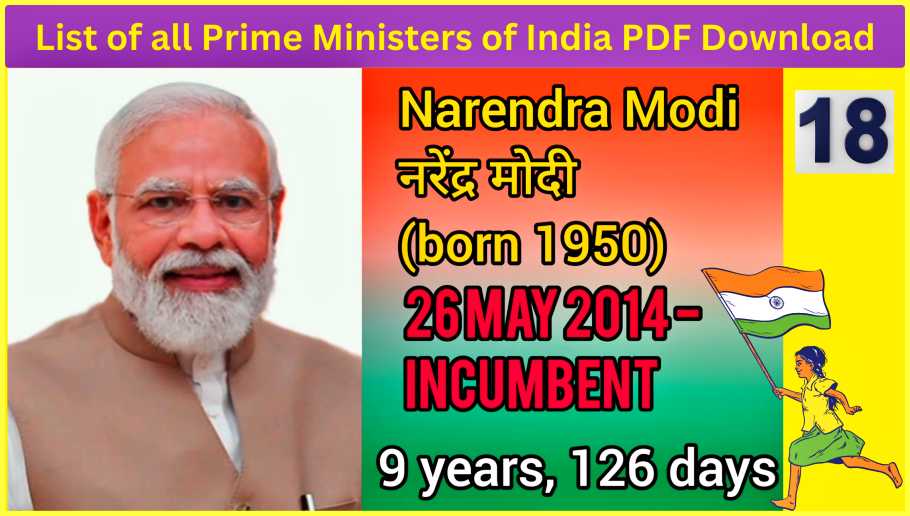
Narendra Modi, the 14th and current Prime Minister, has focused on economic initiatives such as ‘Make in India’ and ‘Digital India.’ His tenure has also witnessed significant social reforms and efforts to enhance India’s global standing.
Here is a comprehensive biography table covering all important topics related to Narendra Modi:
| Full Name | Narendra Damodardas Modi |
|---|---|
| Born | September 17, 1950 |
| Place of Birth | Vadnagar, Bombay State, India (now in Gujarat, India) |
| Education | Bachelor’s degree in Political Science from University of Delhi |
| Spouse | Jashodaben Narendrabhai Modi (married in 1968, separated) |
| Occupation | Politician, Prime Minister of India (since May 26, 2014) |
| Political Party | Bharatiya Janata Party (BJP) |
| Key Roles | – Fourteenth Prime Minister of India (May 26, 2014 – present) |
| – Chief Minister of Gujarat (2001-2014) | |
| Notable Achievements | – Launched several economic and infrastructural initiatives under the “Make in India” and “Swachh Bharat Abhiyan” campaigns |
| – Implemented Goods and Services Tax (GST) in India in 2017 | |
| – Initiated demonetization in 2016 to curb black money and corruption | |
| – Launched “Pradhan Mantri Jan Dhan Yojana” to promote financial inclusion | |
| Key Policies | – Economic Reforms: Focused on economic growth, development, and improving ease of doing business in India |
| – Infrastructure: Prioritized building infrastructure, including highways and railways, to boost connectivity | |
| – Foreign Policy: Emphasized “Act East” policy and strengthened India’s ties with global powers | |
| – Social Initiatives: Launched various social welfare programs, including the Ujjwala Yojana (LPG connection scheme) and Ayushman Bharat (healthcare scheme) | |
| Legacy | Narendra Modi is known for his dynamic leadership, focus on economic development, and aggressive foreign policy. He is credited with implementing several key reforms and initiatives to transform India’s economy and infrastructure. His tenure as Prime Minister has been marked by significant policy changes and efforts to position India as a global player in various sectors. |
Narendra Modi’s leadership style, economic policies, and initiatives aimed at social welfare have had a significant impact on India’s development landscape. He remains a prominent and influential figure in Indian politics.
Table of All Famous Books Written by Narendra Modi
As of my knowledge cutoff in September 2021, Narendra Modi, the 14th Prime Minister of India, has authored several books, primarily on themes related to governance, politics, and development. Here’s a list of ten famous books written by him along with short descriptions:
| Book Title | Description |
|---|---|
| “Convenient Action: Gujarat’s Response to Challenges of Climate Change” | Focuses on climate change and Gujarat’s initiatives in areas like renewable energy, conservation, and sustainable development. |
| “Jyotipunj” | Profiles sixteen leading luminaries of India who inspired Modi. The book portrays their life struggles and achievements. |
| “Sakshibhaav” | A collection of poems reflecting on life, love, and nationalism. |
| “Karmayogi” | Describes the life and vision of Sardar Vallabhbhai Patel, emphasizing his qualities of leadership, governance, and nation-building. |
| “Aankh Aa Dhanya Che” (Gujarati) | An autobiographical book that reflects on Modi’s early life, his journey into politics, and his experiences as a public servant. |
| “Samajik Samarasta” (Gujarati) | Discusses the idea of social harmony and unity, emphasizing the importance of inclusivity and equality in society. |
| “Education of the Girl Child” | Focuses on the importance of educating girls and empowering women, advocating for gender equality and social progress. |
| “Exam Warriors” | A self-help guide for students offering tips, anecdotes, and activities to cope with exam stress and build resilience. |
| “Letters to Mother” | A compilation of letters written to his mother while he was away on political assignments, reflecting his emotional side and family values. |
| “The Transformation of Nature in Art” (Gujarati) | Discusses the interplay between art, nature, and spirituality, exploring how artists have depicted nature in their creations. |
Please note that the availability and titles of books might change over time. For the most current information, it’s best to refer to book retailers or official sources.
Key Initiatives and Accomplishments of Indian Prime Ministers
Here’s a more informative table summarizing the key initiatives and accomplishments during the tenure of each Indian Prime Minister:
| Prime Minister | Key Initiatives and Accomplishments |
|---|---|
| Jawaharlal Nehru | – Industrialization: Launched comprehensive industrial policies, leading to the establishment of key industries.
– Educational Reforms: Founded IITs, IIMs, and AIIMS, transforming India’s education sector. – Non-Aligned Movement: Played a crucial role in the global Non-Aligned Movement, advocating neutrality during the Cold War. |
| Gulzarilal Nanda | – Interim Prime Minister: Served twice as interim Prime Minister during transitional periods, ensuring stability.
– Economic Policies: Focused on economic stability and growth during his short terms. |
| Lal Bahadur Shastri | – Green Revolution: Implemented agricultural reforms, leading to significant growth in food production (Green Revolution).
– Indo-Pakistani War: Led India to victory in the 1965 India-Pakistan war, ensuring national security. – White Revolution: Promoted dairy development, enhancing milk production (Operation Flood). |
| Indira Gandhi | – Nationalization: Nationalized major banks and industries, aiming to create economic self-reliance.
– Green Revolution: Implemented agricultural policies leading to increased food production. – Emergency: Declared a state of emergency (1975-1977) to maintain law and order, controversially suppressing civil liberties. |
| Morarji Desai | – Economic Reforms: Emphasized economic liberalization, reducing government control in various sectors.
– Prohibition: Advocated for alcohol prohibition in certain states, focusing on social reforms. – Nuclear Tests: Oversaw India’s first successful nuclear test, “Smiling Buddha,” in 1974. |
| Charan Singh | – Agricultural Reforms: Implemented agricultural policies and land reforms, supporting farmers’ welfare.
– Economic Policies: Worked towards economic stability, focusing on inflation control. – Farmers’ Rights: Advocated for farmers’ rights and welfare, supporting agricultural communities. |
| Rajiv Gandhi | – Technology and IT: Spearheaded the computer revolution, bringing modern technology to India.
– Anti-Defection Law: Passed the 52nd Amendment Act, preventing political defections. – Youth and Education: Focused on education reforms, empowering youth for India’s future growth. |
| Vishwanath Pratap Singh | – Mandal Commission: Implemented the Mandal Commission recommendations for reservations, aiming for social justice.
– Economic Reforms: Focused on economic liberalization, introducing reforms to boost economic growth. – Social Justice: Advocated for social justice, promoting inclusivity in policies and opportunities. |
| Chandra Shekhar | – Economic Policies: Continued economic reforms, emphasizing liberalization and stabilization measures.
– Nuclear Policies: Upheld India’s nuclear policies and stance on non-proliferation. – Coalition Politics: Led a coalition government, ensuring political stability during his tenure. |
| P.V. Narasimha Rao | – Economic Reforms: Initiated significant economic liberalization, opening up the Indian economy to global markets.
– Nuclear Policies: Upheld India’s nuclear policies, focusing on national security. – Social Welfare: Introduced NREGA, a flagship employment guarantee program, supporting rural development. |
| H.D. Deve Gowda | – Economic Reforms: Continued focus on economic reforms, aiming for liberalization and growth.
– Coalition Politics: Led a coalition government, ensuring political stability during his term. – Agricultural Policies: Implemented policies supporting farmers and rural development, focusing on agricultural growth. |
| I.K. Gujral | – Foreign Policy: Emphasized foreign policy initiatives, especially in South Asia, promoting regional cooperation.
– Coalition Politics: Led a coalition government, ensuring political stability during his tenure. – Economic Reforms: Continued economic liberalization policies, aiming for growth and development. |
| Atal Bihari Vajpayee | – Economic Reforms: Championed economic liberalization, privatization, and globalization, boosting economic growth.
– Pokhran-II: Oversaw India’s second successful nuclear tests, demonstrating India’s nuclear capabilities. – Infrastructure: Launched the Golden Quadrilateral project, enhancing national highways and connectivity. – Peace Initiatives: Undertook peace initiatives with Pakistan, including the Lahore Summit, promoting regional stability. |
| Manmohan Singh | – Economic Reforms: Implemented major economic liberalization policies, opening up the Indian economy and promoting growth.
– Nuclear Deal: Negotiated the Indo-US Civil Nuclear Deal (2008), strengthening India’s global standing. – Social Welfare: Introduced NREGA, supporting rural employment, and worked on various social welfare schemes. – Foreign Policy: Improved relations with the USA and other key global partners. |
| Narendra Modi | – Swachh Bharat Abhiyan: Launched a nationwide cleanliness campaign, promoting sanitation and hygiene across India.
– GST Implementation: Introduced the Goods and Services Tax, simplifying India’s indirect tax system. – Digital India: Promoted digital technology and e-governance initiatives, advancing India’s technological landscape. – Make in India: Championed the “Make in India” initiative, encouraging manufacturing and boosting economic growth. |
Please note that these summaries provide a broad overview of the initiatives and policies during each Prime Minister’s tenure. Each Prime Minister’s term involved numerous policies, reforms, and challenges that shaped India’s political, social, and economic landscape. For a more detailed and comprehensive understanding of their contributions, further research into each Prime Minister’s term would be necessary.
India’s Parliamentary System and the Role of the Prime Minister
India’s political landscape operates within the framework of a parliamentary system, where the President assumes a largely symbolic and ceremonial role, and the real executive power is vested in the Council of Ministers, headed by the Prime Minister. The Prime Minister, the head of the government, is appointed by the President following a general election victory by a political party. This process underscores the democratic essence of the Indian political system, where the leader of the winning party in the Lok Sabha, the lower house of Parliament, ascends to the position of Prime Minister.
- Crucially, the Prime Minister’s accountability lies with the Lok Sabha, where members are directly elected every five years. The Prime Minister must maintain the confidence and support of the majority in the Lok Sabha to continue governing. This system ensures a constant check on the Prime Minister’s actions and decisions, making the Lok Sabha a vital instrument of democratic oversight.
Furthermore, the Prime Minister’s authority extends beyond ceremonial duties; they possess significant powers in the appointment, removal, and allocation of positions within the Union Council of Ministers and the government. This dual role, as the leader of the executive branch and as the representative of the majority in the Lok Sabha, exemplifies the dynamic nature of India’s parliamentary democracy, where the Prime Minister’s leadership is not just a matter of constitutional formality but a reflection of the people’s will and their chosen path of governance.
Appointment of Prime Ministers of India
The position of Prime Minister in India holds immense significance as the head of the Indian government. The appointment process, as outlined in the Constitution of India, is a vital aspect of the country’s democratic framework. Here’s a detailed look at how Prime Ministers are appointed and their crucial role in the governance of the nation.
- Constitutional Mandate: According to Article 75 of the Constitution of India, the President of India plays a pivotal role in appointing the Prime Minister. The President grants this prestigious position to the leader of the majority party in the Lok Sabha, the lower house of the Parliament of India. A key criterion for this appointment is that the Prime Minister must command the confidence of the majority of the Lok Sabha members.
- Executive Authority and Leadership: The Prime Minister of India leads the Union Council of Ministers, which stands as the highest decision-making body within the Indian government. This leadership role grants the Prime Minister significant executive authority, shaping policies and directing the nation’s governance.
- Historic Milestones: Currently, India is led by its 14th Prime Minister, Narendra Modi. His tenure is noteworthy for being the fourth instance in Indian history where a Prime Minister serves two consecutive terms. This accomplishment is especially historic as he is the first non-Congress Prime Minister to achieve this feat, marking a significant shift in the political landscape of the country.
In this constitutional framework, the Prime Minister’s office stands as a symbol of democratic governance, reflecting the people’s choice through their elected representatives in the Lok Sabha. While the President of India serves as the constitutional and ceremonial head of the state, the Prime Minister’s role remains pivotal in shaping India’s destiny through policy decisions and governance strategies.
How to become a Prime Minister of India
Prime Minister Eligibility Criteria: To be eligible for the position of the Prime Minister of India, an individual must meet the following criteria:
- Citizenship: The candidate must be a citizen of India, holding Indian nationality.
- Membership in Parliament: The individual should be a member of either the Lok Sabha (House of the People) or the Rajya Sabha (Council of States), two houses of the Indian Parliament.
- Age Requirement: If the candidate is a member of the Lok Sabha, they must be above 25 years of age. For members of the Rajya Sabha, the minimum age requirement is 30 years.
- No Office of Profit: The candidate must not hold any office of profit under the government of India. This ensures that the individual’s allegiance and focus remain solely on their role as the Prime Minister without any conflicting interests.
- Education: No specific educational qualifications mandated by the Constitution to become the Prime Minister.
Here is a simplified table demonstrating the chronological steps on how one becomes the Prime Minister of India, with a hypothetical example:
| Step | Description | Example |
|---|---|---|
| 1. General Elections | General elections are held every five years to elect members to the Lok Sabha. | General Elections held in 20XX |
| 2. Majority Win | A political party or coalition must secure a majority in the Lok Sabha (272 out of 543 seats) to form the government. | Party XYZ wins 300 seats out of 543 |
| 3. Party’s Choice | The political party or coalition leader is chosen as the Prime Ministerial candidate. | Leader ABC chosen as the candidate |
| 4. President’s Invitation | The President of India invites the leader of the majority party or coalition to form the government. | President invites Leader ABC |
| 5. Parliamentary Approval | The Prime Ministerial candidate proves majority in the Lok Sabha through a vote of confidence. | Vote of confidence passed in Lok Sabha |
| 6. Formal Appointment | The President formally appoints the Prime Minister. | Leader ABC is formally appointed |
| 7. Oath of Office | The newly appointed Prime Minister takes the oath of office and secrecy. | Leader ABC takes the oath of office |
Please note that the example provided (Leader ABC and Party XYZ) is fictional and for illustrative purposes only. The actual political parties and leaders may vary based on real election results.
Powers and Functions of the Prime Minister of India
The Prime Minister of India, as the chief executive of the nation, possesses a wide range of powers and functions crucial to the effective functioning of the government. Here’s an overview of the key roles undertaken by the Prime Minister in serving the country:
- Chairman of the Cabinet: One of the fundamental roles of the Prime Minister is serving as the Chairman of the Cabinet. In this capacity, the Prime Minister presides over cabinet meetings, providing leadership and direction to the collective decision-making process. Important policies, decisions, and strategies vital to the nation’s governance are discussed, formulated, and decided upon during these sessions.
- Representation at International Conferences: The Prime Minister represents India at high-profile international conferences and summits. By doing so, the Prime Minister plays a crucial diplomatic role, fostering relationships with other nations and promoting India’s interests globally. Through these interactions, the Prime Minister strengthens bilateral ties, participates in global discourse, and advances India’s stance on various international issues.
- Ministerial Appointments: The Prime Minister holds the responsibility of proposing suitable candidates from their political party to the President for appointment as ministers in the government. This strategic selection process is vital for assembling a competent and diverse team capable of addressing the nation’s multifaceted challenges. The Prime Minister’s choices significantly influence the composition and effectiveness of the government.
- Control over Cabinet Ministers: The Prime Minister exercises direct control and authority over the functioning of cabinet ministers. By ensuring coordination and collaboration among various government departments, the Prime Minister plays a pivotal role in maintaining effective governance. Through regular interactions and oversight, the Prime Minister ensures that policies are implemented efficiently, government initiatives are carried out effectively, and the overall administration runs smoothly.
In essence, the Prime Minister of India stands as a linchpin in the country’s political structure. Through strategic decision-making, international representation, ministerial appointments, and effective control over the cabinet, the Prime Minister shapes the nation’s present and future, steering India towards progress, stability, and prosperity.
Conclusion: The journey of India’s Prime Ministers is a tapestry of diverse ideologies, challenges, and achievements. From the nation’s inception to the present day, these leaders have steered India through the complexities of governance, leaving an indomitable legacy that continues to shape the nation’s destiny. Their contributions serve as a testament to India’s democratic spirit, resilience, and unwavering commitment to progress.
Also Read:


